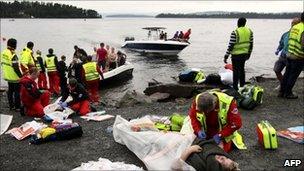Norway attacks: Breivik taken back to shooting island
- Published
Breivik returns with police to the island of Utoeya - courtesy VG TV
Norwegian gunman Anders Behring Breivik has been taken back to the island of Utoeya for a police reconstruction of the killing of his 69 victims there.
Mr Breivik, wearing a bulletproof vest and tethered on a rope, was seen pointing to where he had fired shots. Police later said he showed no remorse.
Mr Breivik's attacks on 22 July also killed eight people in an Oslo bombing.
The 32-year-old far-right extremist admits the killings but denies any criminal guilt.
'New details'
Norwegian prosecutor Paal-Fredrik Hjort Kraby said Mr Breivik described the killings in detail during his eight hours on the island with police.
"Regarding the suspect's explanations, he has been interrogated for almost 50 hours prior to this and he has remained calm, detailed and co-operative, which he also was at Utoeya," he said.
"Our assumptions that his presence at Utoeya would jog his memory was correct. Many new details emerged from his explanations."
Mr Hjort Kraby said some of the victims had drowned while trying to swim to safety.

The shootings on Utoeya traumatised Norway
"We feel we have a fairly good overview of how everyone died or was shot now, even though there are still details to fill in."
He continued: "The suspect showed he wasn't emotionally unaffected by being back at Utoeya... but didn't show any remorse."
Police filmed the reconstruction to use in evidence, Mr Hjort Kraby said.
The Verdens Gang newspaper published photographs, external of the reconstruction, saying Mr Breivik was taken to Utoeya at about 1400 local time (noon GMT) on Saturday, with police helicopters flying overhead.
He reportedly went on the same ferry that he took before carrying out the massacre.
Some of the Verdens Gang pictures showed Mr Breivik standing in a firing position, as if aiming a gun towards the water.
Mr Breivik's lawyer, Geir Lippestad, says Mr Breivik believes the massacre was necessary to save Norway and Europe from Muslim immigration. The lawyer has said his client is probably insane.
Act of solidarity
The attack on Utoeya targeted a summer camp of the youth wing of the governing Labour Party. Most of the victims were teenagers or in their 20s. The Oslo bomb was set off near government buildings.
Mr Breivik has been charged under the criminal law for acts of terrorism. The charges include the destabilisation of vital functions of society, including government, and causing serious fear in the population.
At a court appearance on 25 July, Mr Breivik admitted carrying out the attacks but did not plead guilty to the charges.
He was remanded in custody for eight weeks, with the first four to be in solitary confinement.
Politicians in Norway have taken the unusual step of uniting ahead of next month's local elections
There was suspicion at first that he may have had accomplices but prosecutors and police later said they believe he acted alone.
The attacks traumatised Norway, one of the most politically stable and tolerant countries in Europe.
The government has set up an independent "July 22 Commission" to examine the attacks, including investigating whether police reacted too slowly to the shootings at Utoeya.
On Friday, Mr Lippestad said his client had called police 10 times during the shootings to try to turn himself in, but that eight were not answered. The police have not commented.
On Saturday, campaigning began for next month's local elections, with acts of solidarity among rival parties.
Politicians stood side by side and avoided any partisan comments.